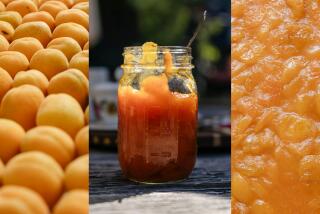Sam and the Country Ham: A Food Fable
- Share via
Sam would still be with us if it weren’t for his Uncle Joe’s ham. Perhaps the gift of a country ham seems like a trivial reason for someone to kill himself. But you have to understand Sam and the nature of the country ham.
Sam, you see, was high up in the trust department of a major bank. He attained his position easily, for he was the most solid, the thriftiest of men. He lived with his mother, doing the cooking until she died.
He established quite a reputation as a gourmet cook, which stayed with him, and was partially responsible for the hams.
For 20 years he had been alone. But not really alone, for his clients were much like his mother. He took very good care of them, and they revered and petted him in the manner of elderly women with a beloved younger man who cared for them. Basking in their attentions, he could have been a very happy man.
If it weren’t for the hams. But the hams drove him mad. Or, to be concise, the last ham put him over the edge.
Every year for as long as he could remember, Uncle Joe, his mother’s brother, had sent him a ham from his home in Smithfield, Va. Sam knew these hams cost in the neighborhood of $100. All the more reason to dread the advent of the ham each year, for Sam was incredibly frugal--with his own things as well as other people’s. Sam still had the first ham Joe had ever sent him when he died.
Not the first Joe had sent to Sam’s mother, however. You see, this had been going on for years. Fear of ham was a generational disease. Sam had tried to cook one once, when his mother was alive. He had invited some friends around, thinking the ham would be the centerpiece, the cornerstone, of a lavish table.
Alas, the party was a failure. The ham had been as solid as a rock of salt. It had tasted like one too. The dog wouldn’t eat it. He had to throw away the bulk of it, and it had nearly killed him then, to waste it even though it was inedible. He felt ridiculed, humiliated.
The next year he had tried to give a ham away to some of the old women he had been able to give recycled fruitcakes in years past. They would have none of it. “Oh, no, Sam,” they would say, in their most loving voice, “I couldn’t take your Uncle Joe’s ham. I just don’t cook anymore, like you do.”
His only victory was when he had walked in on a burglar who had expected to find silver in the silver chest and was stunned to come upon a ham. Sam had gained the moment of surprise and, grabbing the ham, had wielded it like a club, chasing the man from his home.
And so, year after year, the hams had arrived, relentlessly. As the years seemed to grow shorter, the arrival of hams seemed to accelerate. Every closet in his small home had the top shelf dedicated to hams. There they were, piled up against each other, dozens of them.
Finally, he had no more room. There wasn’t even any place under his bed. He was terrified of another failure in cooking the ham, and terrified of giving them away.
Alas, poor Sam died in vain. He could have gained a victory over his ham and each year had a fabulous feast, saving all the money he spent on hiring the country club for his annual party. Here’s how.
When country hams or Smithfield hams have been cured, they are very salty. It is terribly important to scrub them well, then soak them--changing the water three or four times--to remove the excess salt. Don’t worry about mold. It scrubs off and doesn’t mean the meat is bad. If you don’t have a galvanized tub for soaking, use a large cooler--it’s the perfect size. If you are fortunate enough to have a large-enough pan, you may simmer the ham with enough liquid to cover to an internal temperature of 180 degrees.
COUNTRY HAM
1 (12- to 15-pound) country ham
10 quarter-size slices ginger root
1 teaspoon black peppercorns
1/2 gallon apple cider
1 gallon water
1 cup chunky applesauce
3 tablespoons Dijon mustard
1 tablespoon prepared horseradish
1 cup dark brown sugar, packed
1 cup bread crumbs
Scrub ham and soak in water 1 to 2 days, changing water after 4 hours, then daily. Place ham in large pan, fat side up. Add ginger root slices and peppercorns, then enough cider and water to come 2 to 3 inches up side of ham. Reserve remaining cider/water to add to pan as liquid evaporates.
Cover and bake at 350 degrees about 20 minutes per pound or until internal temperature registers 160 degrees. Remove from oven halfway through cooking time and turn ham over. Continue cooking until done.
Remove ham to broiler rack and let rest 10 minutes. Remove skin and fat. (Taste at this point. If terribly salty, ham may be safely immersed in more apple cider and water to draw out more salt. Taste again and proceed. Or refrigerate until ready to glaze.)
To glaze, increase oven temperature to 400 degrees. Combine applesauce, Dijon mustard, horseradish and 1/2 cup brown sugar and mix well. Spread mixture over ham. Bake 20 minutes or until ham is heated through and sauce is bubbly. Remove from oven and turn on broiler. Mix together remaining 1/2 cup brown sugar and bread crumbs and spread over ham. Broil 5 minutes or until topping is crisp. Makes 16 servings.
More to Read
Eat your way across L.A.
Get our weekly Tasting Notes newsletter for reviews, news and more.
You may occasionally receive promotional content from the Los Angeles Times.










